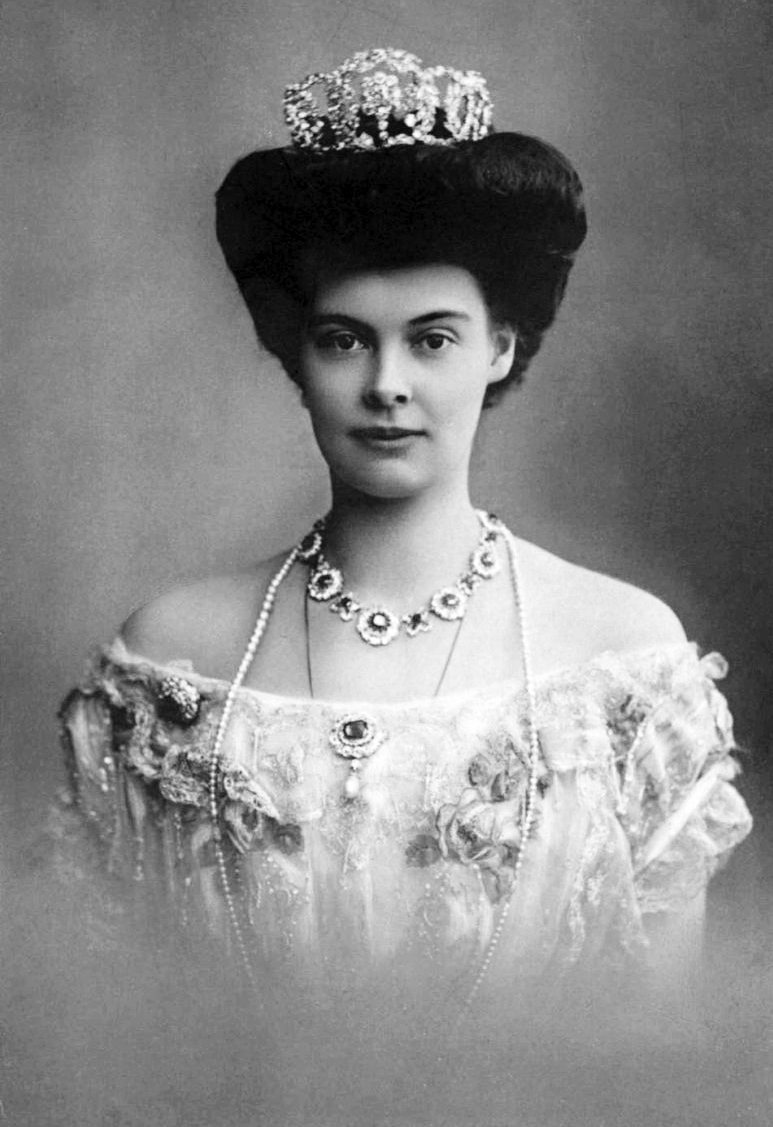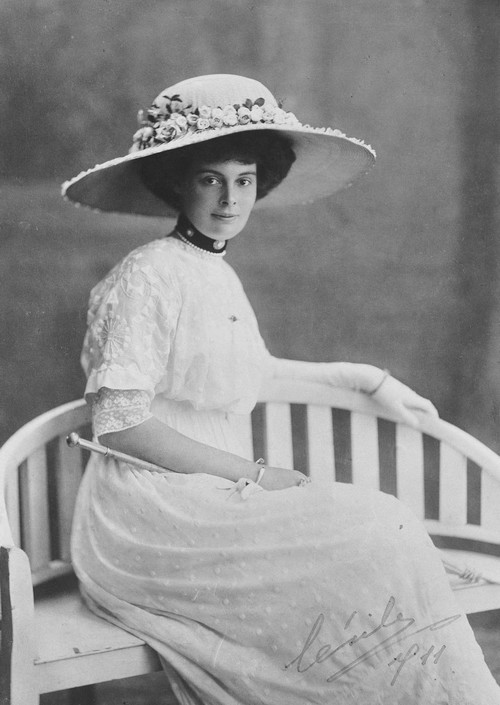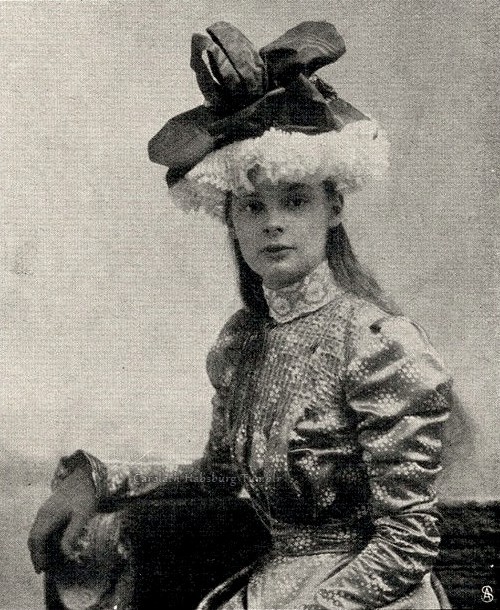Duchess Cecilie of Mecklenburg-Schwerin
Cecilie Auguste Marie Duchess of Mecklenburg ( Schwerin ) ( born September 20, 1886, Schwerin Castle, † May 6, 1954 in Bad Kissingen, Bavaria ) was the daughter of Grand Duke Friedrich Franz III. of Mecklenburg and Grand Duchess Anastasia Mikhailovna Romanova. She was the wife of William of Prussia from 1905 to 1918, the last Crown Princess of the German Empire.
Life
Cecilie was the third and last child of the Grand Duke of Mecklenburg -Schwerin and enjoyed a happy childhood in the Schwerin Castle. On 4 September 1904 she became engaged in the hunting lodge Gelbensande. Nearly a year later, on June 6, 1905, they were married in Berlin with the German Crown Prince Wilhelm of Prussia. The marriage was one of the most spectacular events of the year was celebrated with an elaborate decorated procession from the Brandenburg Gate along the boulevard Unter den Linden until the Berlin City Palace.
Cecilie lived very quickly to their new environment and was exceptionally popular due to their open, but quiet way, both on the farm as well as the people. In contemporary sources was emphasized above all their natural beauty and their fashionable, elegant appearance. In fact, she was very fashion-conscious, had a weakness for hats and was very soon a model for thousands of women and girls in Germany. However, the intelligent woman not limited their power to good looks, but was also very socially engaged. Accordingly, Cecilie put for example a very for the education of women, which is why a lot of schools and streets are named after her ( today ). Privately, she led a life of harmony, as developed between the couple love and oppose brought the two much respect. In summer, the family lived in the Marble Palace in the New Garden Potsdam; in the winter months they moved into the Crown Prince's Palace, Unter den Linden.
Cecilie's carefree life took after the end of World War I to a temporary end, as she refused, his wife and her husband to go into exile with the assigned Kaiser Wilhelm II. She stayed with her six children as a single in the German capital, where she continued to champion charitable purposes. Although allowed her husband, the former Crown Prince Wilhelm of Prussia to return to Germany in 1923, but the couple had become estranged, especially Wilhelm next to his marriage had many love affairs, including with Gladys Marie Deacon.
Cecilie continued to participate in monarchist -oriented clubs. From 1924 she was the patron of the Federal Queen Louise, a sister organization of the steel helmet.
After the seizure of power by the National Socialists and their allies in 1933 all monarchist associations were dissolved and banned. The former Crown Princess thereupon withdrew permanently from the public and lived from now on on the Cecilienhof in Potsdam. The castle was at the request of Cecilie the summer residence of her parents, the hunting lodge Gelbensande, modeled. There she concentrated mainly on their love of music by hosted private concerts and very soon counted many famous conductors and musicians, such as Bronisław Huberman, Wilhelm Kempff, Elly Ney, Wilhelm Furtwängler and Herbert von Karajan to their closest friends.
In February 1945, Cecilie had to get out of her castle to safety before the approaching Red Army with just a few pieces of their personal property. She fled with the family of her son Louis Ferdinand to Bad Kissingen in Bavaria, where they lived until 1952, at first. Umbrella in a room in the "Fürstenhof ", the sanatorium of the familiar with the imperial family bathing doctor Paul Sotier, then in own apartment From 1952 to 1954 she lived a woman's head in the Stuttgart district.
After the Second World War, the formerly popular Crown Princess was largely forgotten. She died on May 6, 1954 during a visit at home Sotier in Bad Kissingen, probably from a stroke. It lies on the small family cemetery in the officers garden of St. Michael's Bastion buried in the Hohenzollern Castle, where the tombs of Crown Prince Wilhelm and several of their children are.
Drive up
Friedrich Ludwig of Mecklenburg -Schwerin (1778-1819) ∞ 1799 Grand Duchess Helena Pavlovna Romanova (1784-1803)
King Friedrich Wilhelm III. of Prussia (1770-1840) ∞ 1793 Louise of Mecklenburg -Strelitz (1776-1810)
Count Heinrich XLIV. Reuss to Koestritz (1753-1832) ∞ 1783 Baroness Wilhelmine Friederike Auguste Marie Eleonore of GEUDER Gen. Rabenstein (1755-1790)
Count Henrich zu Stolberg - Wernigerode (1772-1854) ∞ 1799 Jenny von Schoenburg - Waldenburg (1780-1809)
Tsar Paul I of Russia (1754-1801) ∞ 1776 Sophie Dorothee of Württemberg (1759-1828)
King Friedrich Wilhelm III. of Prussia (1770-1840) ∞ 1793 Louise of Mecklenburg -Strelitz (1776-1810)
Grand Duke Karl Friedrich of Baden (1728-1811) ∞ 1787 Louise Caroline of Hochberg (1768-1820)
King Gustav IV Adolf of Sweden (1778-1837) ∞ 1797 Frederike Dorothea of Baden (1781-1826)
Grand Duke Paul Friedrich of Mecklenburg -Schwerin (1800-1842) ∞ 1822 Alexandrine of Prussia (1803-1892)
Heinrich LXIII. Reuss to Koestritz (1786-1841) ∞ 1819 Countess Eleonore of Stolberg- Wernigerode (1801-1827)
Tsar Nicholas I of Russia (1796-1855) ∞ 1817 Charlotte of Prussia (1798-1860) ( 1798-1860 ).
Grand Duke Leopold of Baden (1790-1852) ∞ 1819 Sophie Wilhelmine von Holstein -Gottorp (1801-1865)
Grand Duke Friedrich Franz II of Mecklenburg -Schwerin (1823-1883) ∞ 1849 Auguste Reuss to Schleiz - Koestritz (1822-1862)
Grand Duke Michael Nikolaevich Romanov (1832-1909) ∞ 1857 Cecilia of Baden (1839-1891)
Grand Duke Friedrich Franz III. of Mecklenburg -Schwerin (1851-1897) ∞ 1879 Anastasia Mikhailovna Romanova (1860-1922)
Duchess Cecilie of Mecklenburg (1886-1954)
Honors
- She's namesake for which originated in the 1920s and now Grade II listed residence Ceciliengärten in Berlin- Schöneberg.
- The Cecilienallee in Dusseldorf - Golzheim was named in her honor.
- According to her Cecilienhof Palace was named in Potsdam.
- One of the great sailing ships of the first half of the 20th century, a built in Rickmers AG in Geestemünde 1902 four-masted barque, was christened Duchess Cecilie.
- The 1905 diked Cecilienkoog in North Frisia was named after her.
- She was named after the ocean liner Crown Princess Cecilie of the North German Lloyd.
- In 1910, a road connecting the former villages Marzahn and Kaulsdorf was named east of Berlin after her. It was named the street, now largely located in the district Berlin- Heller village, in 1992 again.
- Several schools are named after her. Inter alia Cecilie the school Bielefeld.
Progeny
- Wilhelm Friedrich Franz Joseph Christian Olaf of Prussia ( * July 4, 1906, † May 26 1940 )
- Louis Ferdinand Victor Edward Adalbert Michael Hubertus of Prussia ( born November 9, 1907 † 25 September 1994),
- Hubertus Karl Wilhelm of Prussia ( * September 30, 1909, † April 8, 1950 )
- Friedrich Georg Wilhelm Christoph of Prussia ( 19 December 1911 *, † April 20, 1966 )
- Alexandrine Irene of Prussia ( * April 7, 1915; † 2 October 1980)
- Cecilie Viktoria Anastasia Zita Thyra Adelheid of Prussia ( born September 5, 1917 † April 21, 1975 )
Works
- Summer at the lake. Insel-Verlag, Leipzig 1914, DNB 572,584,849th
- Memories. Koehler Verlagsgesellschaft, Leipzig 1930 ( Reprint: Koehler & Amelang, Munich / Berlin 2001, ISBN 3-7338-0304-3 ).
- Memories of the German Crown Prince. Koehler Publishing Company, Biberach an der Riss, 1952 ( reprint: Koehler & Amelang, Munich / Berlin 2001, ISBN 3-7338-0315-9 ).










